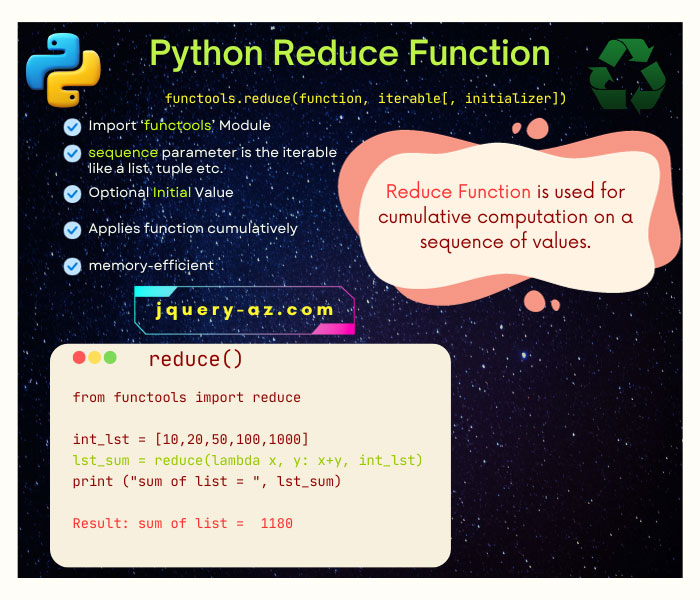
What is the reduce function in Python?
- The reduce function is used for cumulative computation on a sequence of values.
- You have to import functools Module before using reduce function
- The reduce function takes two required and an optional parameter as follows:
Working of reduce Function
This is how the reduce function works:
- It will apply the given function of two arguments to the items of iterable e.g. a list. It applies function cumulatively.
- The items of the sequence are entertained from left to right and the function will “reduce” the sequence to a single value.
I will explain how initialize argument works, first consider the following piece with two arguments:
lst = [5,10,20,40] product = reduce(lambda x, y: x*y, lst)
The reduce will calculate as follows:
If no initialize argument is given then the first item from the list is used as x and multiplied by y. This is followed by multiplication by next item with the accumulated result and so on. So, the above code should result:
That is:
5 * 10 = 50
50 * 20 = 1000
1000 * 40 = 40000
So, the end result is reduced to a single value from the list i.e. 40000.
If the third argument (initializer) is given then it is placed before the items of sequence i.e. acts as x. For example:
lst = [5,10,20,40] product = reduce(lambda x, y: x*y, lst, 5)
In that case, this is how the calculation is done:
5 * 5 = 25
25 * 10 = 250
250 * 20 = 5000
5000 * 40 = 200000
If the given sequence (in the above case, a list) was empty then this initializer would act as the default value.
Still now clear? See the next section with the code and output to make things clearer.
A simple example of reduce function
In this example, the reduce function is used with the lambda function.
In the reduce function, lambda acts as the first argument while a list of int items acts as the second. No third item is given, so the first item of the list acts as x.
See how we get the sum of that list of items:
#Getting sum of a list by reduce
from functools import reduce
int_lst = [10,20,50,100,1000]
lst_sum = reduce(lambda x, y: x+y, int_lst)
print ("The sum of list items = ", lst_sum)
The result:
The example of using initializer argument
In this example, I am using a tuple rather than a list. Besides, the third argument (initializer) is also given to act as the first value (x) in the reduce function.
Have a look:
#Getting sum of a tuple by reduce
from functools import reduce
int_tupl = (10.5,20.4,50.5,100.4,75.6)
tup_sum = reduce(lambda x, y: x+y, int_tupl, 100)
print ("The sum of tuple items = ", tup_sum)
The result:
Using operator with reduce function example
In this example, a list of string items is concatenated by using the reduce function with the operator.
In the reduce function, the operator.add is passed as the function while the second argument is a list that contains string items.
See the code and output below:
#Reduce with operator.add
import functools, operator
str_list = ("This ", "is ", "string ", "concat ", "by ", "reduce")
concat_list = functools.reduce(operator.add, str_list)
print(concat_list)
The output:
